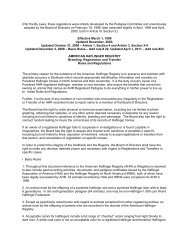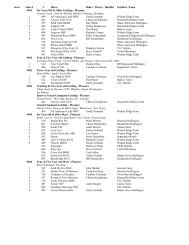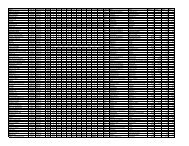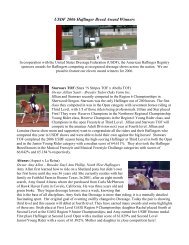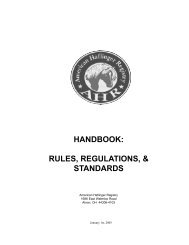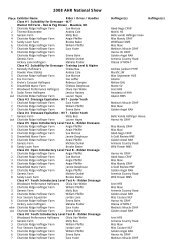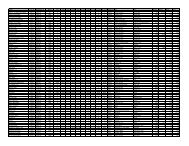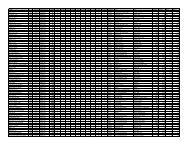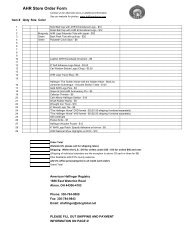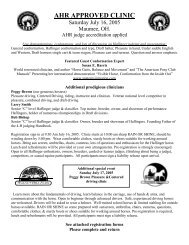handbook - American Haflinger Registry
handbook - American Haflinger Registry
handbook - American Haflinger Registry
Create successful ePaper yourself
Turn your PDF publications into a flip-book with our unique Google optimized e-Paper software.
POLICIES AND PROCEDURES FOR THE AMERCIAN HAFLINGER REGISTRY VOLUNTARY INSPECTION ANDCLASSIFICATION PROGRAM:(Revised August 17, 2005)I. ELIGIBILITY:Open to all purebred <strong>Haflinger</strong> mares, stallions and geldings registered in the <strong>American</strong> <strong>Haflinger</strong><strong>Registry</strong>, and to <strong>Haflinger</strong>s registered with the Canadian <strong>Haflinger</strong> Association that are owned by Canadianresidents. All horses must be owned by members of the <strong>American</strong> <strong>Haflinger</strong> <strong>Registry</strong>.A) Official Inspection and ClassificationOpen to all <strong>Haflinger</strong>s age two or over.B) Informal EvaluationWeanlings and yearlings may be informally evaluated at a reduced fee by the three judges strictly to providethe owner with information via a written evaluation record. The informal evaluation scorecard will differ fromthe official scorecard in that each section will be marked as “very good”, “good” or “needs monitoring throughmaturity”, rather than actual point values. In addition, at the conclusion of each evaluation, the owner willreceive the judges’ written and verbal commentary.C) ApplicationsOnly horses with correctly completed paperwork, including application form, copy of pedigree (front and backif necessary to show current owner), copy of DNA results, and full payment shall be eligible to be inspected.Stallions under the age of two years are exempt from providing DNA results, unless required by AHRregistration rules.II: CRITERIA:A) For horses presented for Official Inspection and Classification, the 100-point system (see attached scorecard)will be used in conjunction with the published breeding objectives of the World <strong>Haflinger</strong> Federation and the<strong>American</strong> <strong>Haflinger</strong> <strong>Registry</strong>.B) Horses presented for Official Inspection and Classification will be measured for height, girth and bone.III: JUDGING:Horses will be judged standing, walking on a small triangle, and trotting on the large triangle. In addition, they willbe free-schooled at trot and canter. Informal evaluation will not include a free-school.IV: JUDGES AND OFFICIALS:A) A panel of three judges will preside at each inspection and classification.B) A minimum of one of the three judges must be of International stature.C) The <strong>American</strong> <strong>Haflinger</strong> <strong>Registry</strong> must approve all three judges.D) A judge may not preside at the classification of a horse that was bred by, owned by, sold by or handled asagent by him/her or members of his/her immediate family.E) The judges will be responsible for verifying soundness as well as the absence of any genetic defects.F) A representative of the registry will be present to examine pedigrees and to take a DNA sample to confirmidentity.V: SCORING FOR OFFICIAL INSPECTION AND CLASSIFICATION:A) Horses will be given a mark out of 10 possible points for each of the following categories:1. Type 6. Hindquarters2. Head 7. Front Legs3. Neck 8. Hind Legs4. Forehand 9. Correctness of Movement5. Mid-Section 10. Overall Movement47




